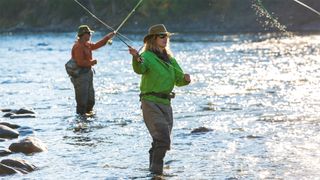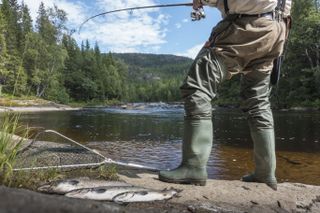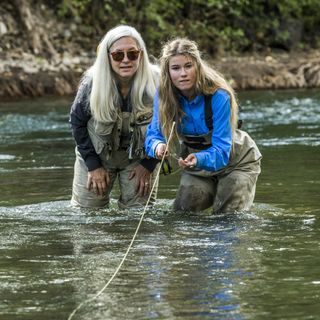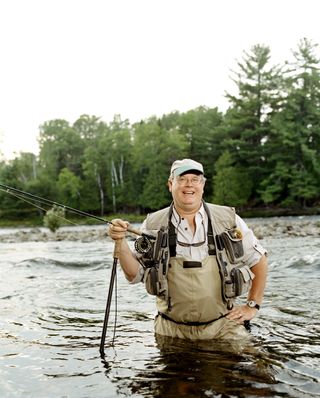How to choose waders: selecting the best wader boots for all types of fishing
Discover how to choose waders for fishing in saltwater or freshwater, for every style of fishing and body type, and every season

Confused about how to choose waders for fishing? With dozens of styles, features and designs available, it's not easy knowing what you should look for when choosing a wader boot for fishing in freshwater or saltwater.
And while there are still anglers who simply pull on old tennis shoes and short pants, and wade off toward the sunset, there is an abundance of modern fishing waders available that not only make the process more comfortable, but more enjoyable, too.
This is noteworthy because a more comfortable, warm, happy and focused angler is one who catches more and bigger fish. And this is particularly true for wading anglers, regardless of whether you fish freshwater or saltwater.
Thinking about how to choose waders for fishing can be a minefield for even an experienced angler, but after reading this in–depth guide you’ll have a great understanding of how to find the best wader boots for fishing.
How to choose waders: why wear wader boots for fishing in the first place?
Waders are a valuable tool for almost any angler, but asking yourself about your baseline reasons for wearing waders will help you decide on the best ones to choose when you're planning your next fishing trip.
A few years ago, for example, while summer surf–fishing at a warm coastal inlet, we wore only shorts and old sneakers, and had great success tossing jigs and plugs around a sunken rock pile.
But after about an hour fishing, one of us was painfully stung by a jellyfish on the leg. After that, we didn’t wade back into the inlet for fear of being stung again. So we couldn't reach the rock bar with casts, and my catch rate dropped to zero.
Advnture Newsletter
All the latest inspiration, tips and guides to help you plan your next Advnture!
This proved to us that leg and foot protection is important to many waders, even when the water is warm and inviting. Sturdy tennis shoes and long pants used to serve waders well in warm water, but these days there are other, better alternatives.
Warmth is a factor for many and waders often offer crucial insulation to fisherfolk, regardless of low water temperatures or inclement weather. A good set of waders can make the whole process of going fishing a pleasure, rather than a battle against the elements.
Next, we’ll explore the different types and styles of fishing waders available to choose from with the benefits and pitfalls of each.
How to choose waders: hip waders, “hipper” boots for fishing – are they a good option?

Lightweight and easy-to-pull-on hip boots are good for some types of shallow-water fishing, especially in small, shallow streams and ponds. “Hippers” (as they’re sometimes called) are simple and fast to use, and they’re less expensive and cumbersome than chest-high waders.
But hip boots can limit even shallow-water fishing effectiveness because crossing a creek, surf break or pond to a better fishing spot may lead to encountering water deeper than hip boot protection offers, which is a recipe for problems.
In reality, they offer great protection on your legs and feet in shallow water, but they’re not that practical elsewhere compared to other types of waders. We'd suggest you think carefully about the kinds of water you're likely to be wading in and how deep that water could realistically get before purchasing hip or thigh–high waders.
How to choose waders: why chest waders are the best choice for fishing waders

For anglers who want full leg covering, or want to keep warm and dry while wading, chest-high waders are in order. The variety of chest-high waders available to anglers today is amazing and these will cover you for most of the everyday fishing you’re likely to experience.
They come in all sizes, shapes and designs, some even made expressly for females and youngsters. They can be had in more material types than it’s possible to keep pace with.
And some waders even have a front-zipper, no-leak "fly" – something always needed but never believed possible in wader design. This style is the best for all–round wading and fishing.
How to choose waders: choosing the best boot design for your fishing waders

The first task when choosing waders for fishing is to work out what sort of wader boot design is most suitable with consideration given to cost, durability and practicality.
Some waders are "stocking foot" design, meaning they have no boot. These types of waders demand that an additional wading shoe be worn with them. Tennis shoes or sneakers can be used, but a specially-designed wading boot is better.
Some look like hunting boots, with laces and hard soles for safely clambering around rocky riverbeds. This combination is ideal for freshwater fishing in lakes, ponds, streams, creeks or rivers.
For saltwater fishing, pull-over neoprene booties covering the stocking-style feet may be preferred, as they eliminate hardware like eyelets and protect the stocking soles from wearing on stones and shells. They’re also easier to walk the beach in, offer less resistance to waves and current, don’t load up with sand like a more open boot and they rinse off easily.
Plain rubber-sole boot-foot waders – the type with built-in boots – are satisfactory for much fishing, especially if firm sand, mud or small shell-bottom waters are worked. Such boot-foot waders also are generally less expensive than felt-sole boots, so they’re a good all-round option, especially for someone’s first pair of waders or infrequent use.
Felt–sole boot–foot waders are designed chiefly for stream anglers for non–slip walking on slick rocks and gravel. They also are good on slick shells, rocks and jetties, making them suitable for coastal anglers wading for fluke, striped bass, bluefish, surf perch, rockfish, croaker and other species. These tend to be a little bit more expensive than other configurations and are usually selected by more experienced anglers tackling trickier grounds.
How to choose waders: choosing the best waders for fishing in warm water and warm weather
Thinking about what sort of water temperature you might be using your waders in is important as it can help decide the type of material and thickness. With too much insulation, you’ll quickly become overheated in the wrong type of waders, and sweaty waders aren’t pleasant!
For warm–weather wading, a very thin material or "featherweight" wader is a good choice. They are usually low priced and their "thin-wall" designs are a joy to use. Even in the hottest weather or water, such waders are comfortable, especially if they’re made from a breathable material such as neoprene, making this a great choice for warm water waders.
How to choose waders: choosing the best waders for fishing in cold water and weather

For cold-weather fishing, heavy rubber or canvas insulated waders are in order. Many winter and autumn anglers wear such waders, and they are a wise choice for use in water temperatures below about 70ºF / 21ºC. Remember that wading in water having a temperature less than your body temperature causes body heat loss, and that becomes uncomfortable in a short time.
Neoprene waders are popular for anglers fishing cold water and are perhaps the best all-round choice when it comes to construction material. Neoprene once had a reputation for being "too hot" and "too expensive". However, lightweight neoprenes are made now that are cooler than the original heavy styles, and their prices are more in line with other quality waders made from other materials.
One benefit of neoprene over canvas or rubber waders, is that neoprene is the most comfortable of all waders for all body shapes and types. Stretchy neoprene waders fit your body like a glove, and so are less bulky than other wader material designs.
Another important plus for neoprene waders is that they are more durable than other wader styles. They also can be permanently repaired in seconds with special glue, even right on the water. They’re often a little more expensive compared to other types but the cost is generally worth it if you’re considering regular use over a number of seasons.
How to choose waders: other factors to consider when buying and choosing fishing waders

Most chest-high waders require an angler to wear suspenders - these are stretchy straps hooked over the shoulders to hold the waders up. Buy good ones, preferably with the H-shaped back design, and made from wide fabric that prevents cutting into shoulders and back. Get suspenders with minimal metal, as they may rust and that can damage boots.
For any wader wearer, an exterior waist belt is crucial for safety. The idea is that if you wade in over your head or fall, the belt will trap air inside so you'll float, rather than have waders fill with water and sinking. This makes sense. But a waist belt around waders also is comfortable - especially for anyone who has grown accustomed to modest pressure at the waist from years of wearing belts on pants.
Safety is paramount – please follow all guidelines and take care when wearing waders, especially in surf or turbulent conditions. Make sure that you are well within your depth range, especially when waves and tides are involved. Use a wading staff or pole to test unfamiliar ground. Always fish with others and within sight of someone who can help, should you get into difficulty.
Knowing how to choose the best waders for your style of fishing can be the difference between a great trip and a cold, fishless one. So, it’s worth spending time on choosing the right type and, from the information in this guide, working out what combination of style, boot type and material suits you best.
Bob McNally has been around fishing and the outdoors all his adult life. He caught his first sailfish at age nine, his first tarpon and bonefish at age ten.
In addition to writing thousands of newspaper outdoor stories and feature magazine articles on fishing, multi-award-winner Bob is the author of 11 outdoor books, including the definitive, best-selling Fishermen's Knots, Fishing Rigs, and How To Use Them. Bob has fished throughout Canada, Mexico, Central and South America, Europe, Cuba and the Bahamas and lives near Jacksonville, Florida with his wife.
Most Popular

